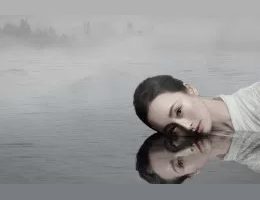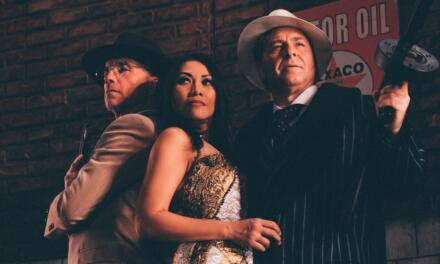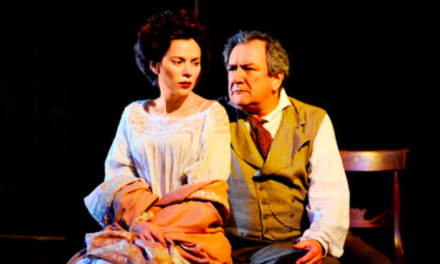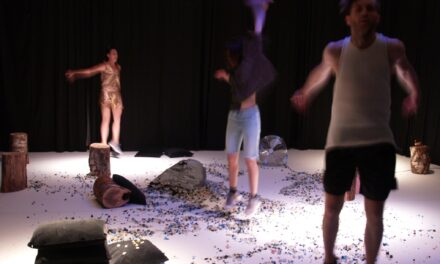The Legend Of White Snake isn’t old–it’s ancient. One of China’s Four Great Folktales (the other three being Lady Meng Jiang, Butterfly Lovers and The Cowherd And The Weaving Maid), the first fictionalization of it is thought to have originated in Ming times. It is, as epics have to be, a story of life and death, of love and loss, of truth, deceits, and transformation.
Now regarded as a cultural treasure and a piece of intangible cultural heritage, The Legend Of White Snake has inspired operas, TV series, and movies, including the 2011 action fantasy The Sorcerer And The White Snake starring Jet Li. And now it’s the basis for Lady White Of West Lake, a newly adapted dance drama choreographed for the Hong Kong Dance Company by artistic director Yang Yuntao.
On Lady White Of West Lake’s evocative poster, a girl in white with porcelain skin lies in a pool of water, her face reflected. The image is set against a stormy grey background. The image seems to recall mist rising from the lake, or else it suggests ethereal water spirits, but the black, white and grey palette has a greater personal significance for the choreographer. While Yang has stuck closely to the storyline, he takes many more moments to contemplate what happens in the elusive grey areas between good and bad.
Traditionally, the story draws from Taoist fascinations with life, death, and immortality, seen particularly through the quest of its main character, Bai Suzhen, to morph from the spiritual realm to the living. Yang’s interpretation makes a study not of life and death, but of what it means to be alive, and whether his dance steps lead him from his own viewpoint or from Bai’s, he kept winding up at the same place: love.
“Life is love,” says Yang. Using the female lead character as his lens, he positions woman in all her forms,–as a fascination, as a wife, a mother, and as the purest demonstration of love. Yang isn’t old but at 42, and a husband and father, he found himself like the central character in the story, examining what it means and what it takes to live, to love and to be loved. He decided to use the story as a springboard, the stage as his exploration space, to explore life, love and everything in between. You could say that he is diving into West Lake feet first.
The actual West Lake is in Hangzhou, and it is famously framed by peach and plum blossoms. It has been the inspirational setting for many long-surviving Chinese tales. Plots take characters to the lake’s crumbling stone bridges and tranquil pagodas, landmarks that still exist today although they are markedly less peaceful thanks to clusters of tourists attempting to weave their own histories into the location’s fabled fabric.
In the original White Snake, a young man named Xu Xian mistakenly buys some immortality pills that, after some mishaps, fall into the lake where a white snake spirit eats them. The spirit has been craving immortality, and in order to thank Xu Xian for the surprise gift of the pills, she transforms herself into the lovely beauty Bai Suzhen to thank him. Gradually, they fall in love, marry and open a medicine shop together.
But as in many folktales, happiness is not an eternal due, and it is permanently challenged and questioned. The green snake spirit, Fa Hai, jealous of Bai finding the pills, and of her marriage, follows her in human form as a monk, exposing Bai’s true identity. Xu Xian, upon hearing the news of deceit and lies, suffers a fatal heart attack that prompts Bai Suzhen to undertake a journey to a faraway Buddhist mountain, where she retrieves a cure that revives her lover. Xu Xian in forgiveness declares his ongoing love for her, snake past and all, which angers even further a furious Fa Hai, who imprisons Xu Xian. He nonetheless manages to escape and returns to Bai in time to see his son born, prompting a further infuriated Fa Hai to locking Bai in a pagoda on the lake for eternity.
Traditional versions of the story focus on the concept of ying and yang, or good and bad. Retellings have cast Bai Suzhen’s snake character both as selfish and deceitful in her pursuit of love, as well as a sorrowful figure to be pitied. Fa Hai has been portrayed as good, protecting Xu Xian from Bai’s demon sorcery, as well as the archetypal bad guy out to destroy Bai’s happiness. Yang wanted to explore what drives the characters to such levels of high drama and deceit.
“We have given Fa Hai a lot of space to explore his motivations,” he says. More is asked of Xu Xian too. He is often described as gentle and good-natured and more a bystander in the story of which he is supposedly a central part. “Shouldn’t he take responsibility for his part in the love story?” asks Yang. He sees this kind of disengagement mirrored in everyday life. Women are more vocal and demonstrative where love is concerned, but Yang would like to see Xu Xian, and all men, stand up for the women in their lives and the love they represent.
Indeed, as he worked on the choreography, Yang reflected on his own relationships, as a son to a mother, a husband to a wife, and as a father to his sons. Rehearsals became revelatory as the choreography pushed him to continually delve deeper and reveal more about himself. The movement also led him to question the worth of his achievements to date, the value of his life, and how he should harness his own potential moving forward. “Sometimes that has been good, at other times it’s been challenging,” he admits.
But positioning the story as Lady White Of West Lake does rely on telling the story with a female in the lead role. So, while Yang’s own life formed the starting point for the production, as his ideas evolved he began using gender as a lens. He projected his emotions and asked how it might feel to be a woman in the stages of freshly requited love, and in marriage, motherhood and then old age.
Next, he turned to the dancers, in particular, Tang Ya and Hua Chi-yu, who will take turns portraying the female lead Bai Suzhen, for their input. The choreography has grown from Yang’s initial observations and conversations with them, and in collaboration with the production’s composer, Yin Ng, who has crafted a spare and haunting score in response to Yang’s directions. The final result shares all of their influences, but it is ultimately Yang’s expression of how he sees women in society. “I see women illustrating the purity of what life is,” he says. “I’m not saying it’s a correct view, but that’s the standpoint I’m coming from.”
The production is a tale weaved of old and new, and we see this in every facet. The score is stripped down made all the more powerful with a capella excerpts that sound otherworldly, fresh and new. Costumes, reflect the space in between good and bad with a palette of white, black and grey, hinting at traditional Chinese dress. Yang has chosen to use the prescriptive movements of Chinese classical dance to re-tell a story that is as much Yang’s story as it is the snake spirit Bai’s.
Previous retellings of the story are divided between a tumultuous tragic ending, which sees Bai end her human life broken-hearted, and a more sympathetic end in which true love wins out. At this point in rehearsals, a definite ending remains undecided, but Yang is not as concerned with the story’s finish as much as he is the unraveling of it. He may even leave things open-ended and let the audience decide, he says. For all to be revealed, we can only wait for opening night.
Lady White Of West Lake runs from November 24 to 26. Click here for more information.
This article was originally written by Elle Kwan for Zolima Citymag on November 14, 2017, and has been reposted with permission.
This post was written by the author in their personal capacity.The opinions expressed in this article are the author’s own and do not reflect the view of The Theatre Times, their staff or collaborators.
This post was written by Elle Kwan.
The views expressed here belong to the author and do not necessarily reflect our views and opinions.


















